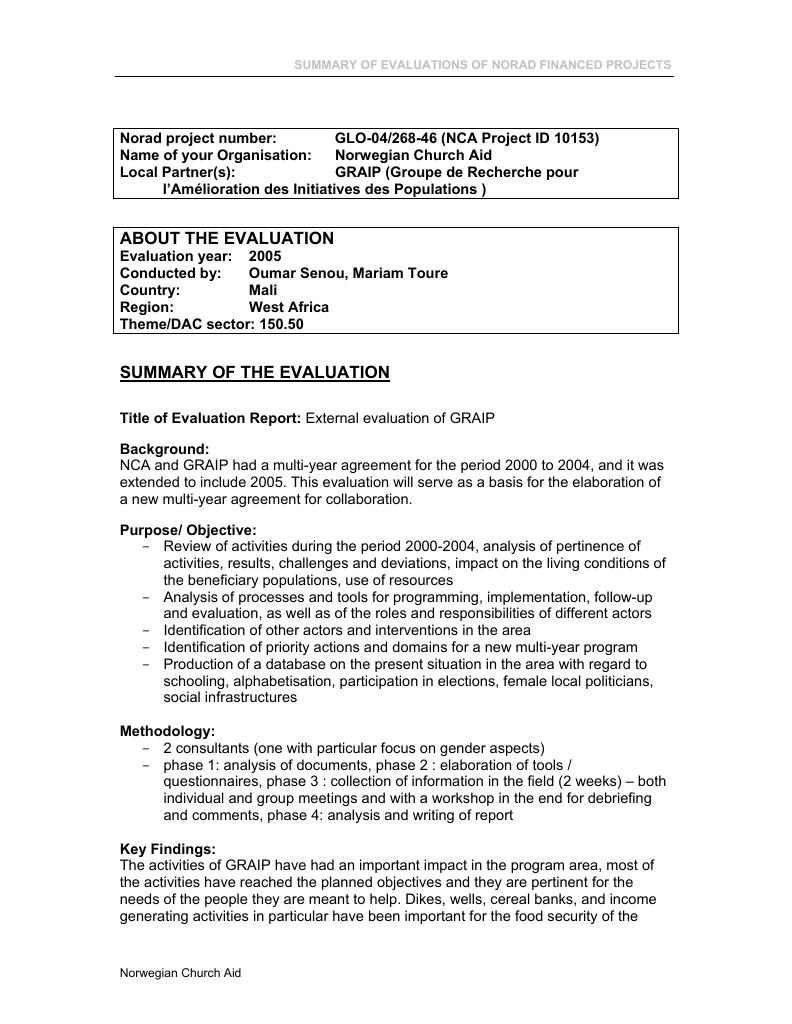Evaluering
External evaluation of GRAIP
Background NCA and GRAIP had a multi-year agreement for the period 2000 to 2004, and it wasextended to include 2005. This evaluation will serve as a basis for the elaboration of a new multi-year agreement for collaboration. Purpose/objective - Review of activities during the period 2000-2004, analysis of pertinence ofactivities, results, challenges and deviations, impact on the living conditions ofthe beneficiary populations, use of resources- Analysis of processes and tools for programming, implementation, follow-upand evaluation, as well as of the roles and responsibilities of different actors- Identification of other actors and interventions in the area- Identification of priority actions and domains for a new multi-year program- Production of a database on the present situation in the area with regard toschooling, alphabetisation, participation in elections, female local politicians,social infrastructures Methodology - 2 consultants (one with particular focus on gender aspects)- phase 1: analysis of documents, phase 2 : elaboration of tools /questionnaires, phase 3 : collection of information in the field (2 weeks) - bothindividual and group meetings and with a workshop in the end for debriefingand comments, phase 4: analysis and writing of report Key findings The activities of GRAIP have had an important impact in the program area, most ofthe activities have reached the planned objectives and they are pertinent for theneeds of the people they are meant to help. Dikes, wells, cereal banks, and incomegenerating activities in particular have been important for the food security of thebeneficiary populations. The activities have also contributed to reduce migration from the areas. Recommendations The recommendations are divided in 4 groups:1 - With regard to Graip:- Concentrate activities and focus on the impact they will have on vulnerablegroups- Improve the planning, monitoring and evaluation system with use of indicators(also impact level) and elaboration of tools such as manuals and writtenpolicies- Integrate gender better in the strategic approach- Identify clear criteria for the choice of beneficiary groups in order to reach themost vulnerable people- Take info account local specificities in planning and implementation strategies- Reinforce technical support staff- Use external technical staff for particular needs- Particular focus on continued reinforcement of management skills of women toensure the sustainability of their associations- Recommendations for the elaboration of a new multi-year program2 - With regard to the associations and final beneficiaries:- Stressing the importance of maintenance, internal mobilisation of resources aswell as participation of beneficiary groups in the identification, planning andcontrol of activities3 - With regard to the collaboration with NCA:- Harmonisation of NCAs and partners strategies for implementation- GRAIP needs support in the following areas: institutional support forelaboration of tools and documents, adequate logistical means, make surethat allocated budget is adequate for programmed activities (need for morefunding to GRAIP to enable them to respond to the needs in the area),capacity building within PME4 - With regard to the activities:- Particular observations with regard to food security, income generatingactivities, schools, training and water
